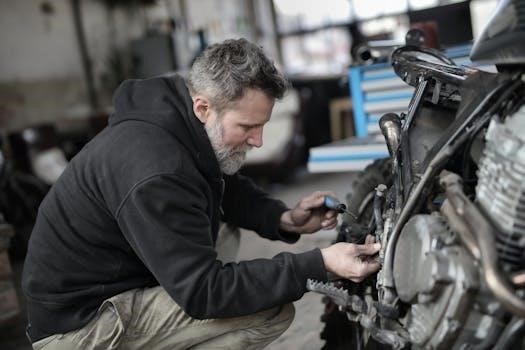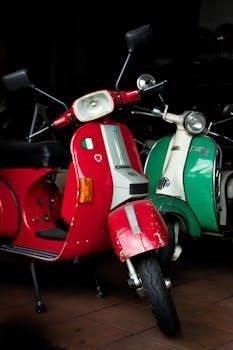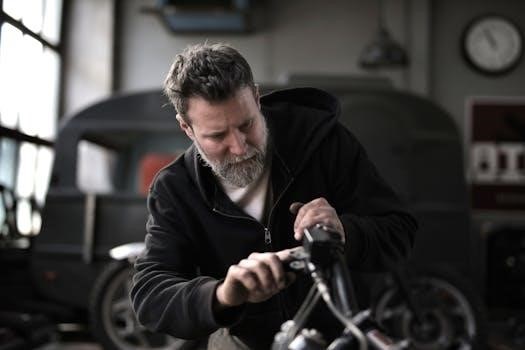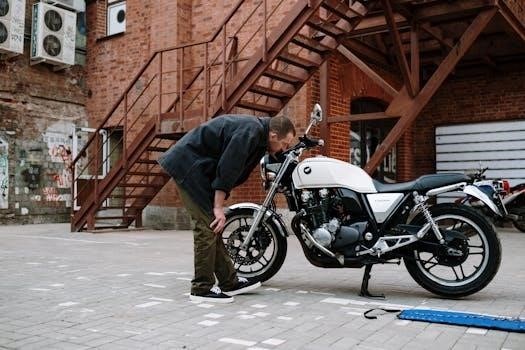motorcycle manual ma
Motorcycle Manual MA⁚ A Comprehensive Guide
This comprehensive guide offers valuable tips and strategies for motorcycle riders, focusing on risk management. It explores various aspects of motorcycle operation, drawing from resources like the Motorcycle Safety Foundation manual, to provide a complete understanding for both novice and experienced riders.
Understanding Motorcycle Transmissions
Motorcycle transmissions are crucial for transferring engine power to the wheels, allowing riders to control speed and acceleration effectively. Like car transmissions, they utilize gears to optimize engine performance across different speeds. However, motorcycle transmissions often feature sequential shifting, requiring riders to move through gears one by one. Understanding these systems is fundamental for safe and efficient riding, as they vary significantly across different motorcycle types. Manual transmissions are common, using a clutch lever and gear shift lever, typically operated by the rider’s left hand and foot respectively. Automatic transmissions, though less common, are gaining popularity, offering a simpler riding experience by eliminating the need for manual gear changes. Semi-automatic transmissions present a middle ground, often using an automatic clutch but still requiring gear shifts. Whether manual, automatic, or semi-automatic, mastering your motorcycle’s transmission is vital for seamless riding and optimal control. These systems use design principles similar to other geared transmissions, first removing load using a clutch before changing gears. This ensures smooth power delivery and protects the engine and transmission components.
Manual Transmission Basics
Manual transmissions in motorcycles require the rider to actively manage gear changes using a clutch and gear shift lever. Typically, the clutch lever is located on the left handlebar, while the gear shift lever is positioned near the rider’s left foot. To change gears, the rider must first disengage the clutch by pulling the lever, then shift to the desired gear, and finally smoothly release the clutch while applying throttle. This process requires coordination and practice to achieve smooth and efficient gear changes. Unlike some car transmissions, motorcycles usually feature a sequential gear pattern, meaning riders must shift through each gear individually (1st to 2nd to 3rd, etc.). This process provides the rider full control over the motorcycle’s power band, allowing for precise acceleration and engine braking. Mastering the manual transmission is crucial for experienced riding and offers a more engaging and connected experience. This type of transmission is very common in motorcycles. The clutch disengages the transmission from the engine. The rider then selects the next gear and re-engages the clutch.
Automatic Transmission Options
Automatic transmissions in motorcycles offer a simplified riding experience by eliminating the need for manual gear shifting. These transmissions handle gear changes automatically based on the motorcycle’s speed and engine load, allowing riders to focus more on steering and balance. While not as common as manual transmissions, automatic options are becoming increasingly popular, especially in scooters and some urban-focused motorcycles. They often use technologies like continuously variable transmissions (CVT), which provide smooth and seamless acceleration without distinct gear changes. Some automatic systems may also include pre-set drive modes that alter shift points for better performance or fuel economy. This type of transmission simplifies the operation of the motorcycle making it more accessible to people with less experience. These systems are often found on scooters and smaller bikes. The absence of a clutch and foot gear shift, makes it very simple to operate. This type of transmission also offers a stress free ride in congested areas. Automatic transmissions can also be found on electric motorcycles.
Semi-Automatic Transmissions
Semi-automatic transmissions on motorcycles represent a middle ground between manual and fully automatic systems. These transmissions remove the need for a clutch lever, simplifying the shifting process but still requiring the rider to actively select gears. Typically, riders use a foot-operated lever to shift up or down, often with a mechanism that automatically engages and disengages the clutch as needed. This type of transmission is often found in smaller motorcycles, scooters, and some underbone models, providing a more engaging riding experience than a fully automatic transmission while still being more user-friendly than a manual. The lack of a hand clutch allows for ease of operation. This makes them a popular choice for those who want a more simple approach to riding. The rider is still required to change gears, but they do not need to manually engage the clutch lever. Semi-automatic transmissions aim to provide a more convenient experience. They allow for quicker gear changes and a more controlled feel. It is important to understand how the system works to ensure smooth gear changes.
Types of Motorcycles
The world of motorcycles is incredibly diverse, with various types designed to cater to different riding styles and needs. This section explores the main categories of motorcycles, providing a brief overview of each. From the rugged adventure bikes built for long-distance travel on varied terrain, to the laid-back cruisers ideal for leisurely rides, there’s a motorcycle type for almost every preference. Sportbikes, known for their high performance and agile handling, offer an exhilarating experience, while touring motorcycles provide comfort and storage for extended journeys. Dual-sport bikes combine on-road and off-road capabilities, and standard motorcycles offer a versatile, everyday option. Off-road motorcycles are designed solely for dirt riding. Understanding these different categories is crucial for choosing the right motorcycle for your individual requirements. Each type presents a unique riding experience, and selecting the correct one will greatly enhance your time on two wheels. The choice of motorcycle also depends on your needs, experience and comfort level. Different types also offer different capabilities.
Adventure Motorcycles

Adventure motorcycles, often styled to resemble vehicles ready for long journeys to remote locations, are the two-wheeled equivalent of a Range Rover. These bikes are designed for versatility, capable of handling both paved roads and challenging off-road terrain. They typically feature long-travel suspension, robust frames, and powerful engines, making them suitable for long-distance touring and exploration. With their upright riding position, they offer comfort for extended periods in the saddle. Adventure bikes are often equipped with features like luggage racks, hand guards, and higher ground clearance. These motorcycles are popular among riders who enjoy exploring diverse landscapes and embarking on long-distance adventures. They provide a blend of comfort, capability, and durability, allowing riders to tackle varying conditions with confidence. The design ethos of these motorcycles emphasizes exploration and resilience, appealing to those with a sense of adventure. Adventure motorcycles cater to a wide range of riders, from those seeking weekend escapes to those undertaking transcontinental journeys. Their popularity stems from their versatility and readiness for any type of journey.
Cruiser Motorcycles
Cruiser motorcycles are characterized by their laid-back riding style, low seat height, and distinctive aesthetic. These bikes often feature a long wheelbase, forward-mounted foot controls, and a relaxed, upright riding posture, which all contribute to their comfortable cruising experience. Cruiser motorcycles prioritize style and comfort over high-performance handling, making them popular for leisurely rides and short to medium distance trips. The design often incorporates chrome accents, swept-back handlebars, and a teardrop-shaped fuel tank, which together create a classic and iconic look. Riders of cruiser motorcycles typically enjoy a relaxed and comfortable riding experience, focusing on the journey rather than the speed. These bikes are also often customizable, allowing owners to add their personal touches and modifications. Cruisers are ideal for riders who appreciate the traditional motorcycle aesthetic and enjoy a comfortable ride. Their focus on style, comfort, and a relaxed riding experience makes them a popular choice for enthusiasts. They offer a sense of freedom and timeless appeal, making them a staple in the motorcycle world. They are not ideal for very long journeys or fast corners.
Sport Motorcycles
Sport motorcycles are engineered for high performance, agility, and speed. They feature aggressive riding positions with a forward lean, which enhances aerodynamics and control at high speeds. These bikes are characterized by their lightweight frames, powerful engines, and advanced suspension systems, designed for optimal handling on both roads and racetracks. Sport motorcycles often incorporate sleek, aerodynamic fairings to reduce drag and improve performance. They typically have a high-revving engine, responsive brakes, and a sensitive throttle, allowing for rapid acceleration and precise cornering. These motorcycles are built for riders who prioritize performance and handling, often at the expense of comfort. Sport bikes are generally not recommended for long rides because of their aggressive riding position, but are ideal for riders who enjoy the adrenaline and excitement of fast, agile handling. They come with a variety of engine sizes and configurations, catering to different levels of skill and experience. The focus of sport motorcycles is always on performance, making them a top choice for those seeking a thrilling and dynamic riding experience. They are designed to be fast and precise, often found at races and track days.
Touring Motorcycles
Touring motorcycles are designed for long-distance comfort and convenience, prioritizing the rider’s well-being over extended journeys. These bikes typically feature large, comfortable seats with backrests, offering ample support for both the rider and passenger; They often include features like adjustable windscreens, fairings, and heated grips to protect riders from the elements, ensuring a more comfortable experience in varying weather conditions. Touring motorcycles are equipped with large-capacity fuel tanks to allow for extended travel without frequent stops. They commonly include integrated luggage systems, such as saddlebags and top cases, providing ample storage for personal belongings. The suspension on touring bikes is designed for a smooth and stable ride, even when carrying a heavy load. They have powerful and torquey engines that allow for easy cruising and confident overtaking. These motorcycles are built for riders who enjoy exploring the open road and traveling long distances. Touring models often include advanced technology features, such as GPS navigation, audio systems, and cruise control, to enhance the riding experience. They are the ideal choice for long trips with the emphasis on comfort and practicality.
Dual-Sport Motorcycles
Dual-sport motorcycles, often called adventure or enduro bikes, are versatile machines designed to excel both on paved roads and off-road trails. These bikes combine features from both street and dirt bikes, making them suitable for a wide range of riding conditions. They typically have longer travel suspension to handle uneven terrain and provide a comfortable ride on rough surfaces. Dual-sport motorcycles are equipped with knobby or semi-knobby tires to offer good grip on various surfaces, from pavement to gravel and dirt. They generally have a more upright riding position, which provides good visibility and control, both on and off-road. These bikes often feature high-mounted exhaust systems to provide more ground clearance for off-road riding. Dual-sport motorcycles are popular among riders who enjoy exploring different terrains and seek versatility in their motorcycles. They are lighter and more nimble than touring bikes, making them easier to handle on trails; Their engines are designed to provide a balance of power and fuel efficiency, making them reliable for both short and long journeys. Dual-sport bikes are adaptable and can be customized with accessories to suit different riding styles and preferences. They are ideal for riders looking for a do-it-all motorcycle.
Standard Motorcycles
Standard motorcycles, also known as naked bikes or roadsters, represent a classic and versatile category of two-wheeled machines. Characterized by their upright riding position, comfortable seat, and exposed engine, standard motorcycles prioritize practicality and ease of use. Unlike sportbikes or cruisers, they don’t lean heavily towards one extreme or the other, making them suitable for a wide range of riders and riding styles. Standard motorcycles offer a balanced approach to motorcycle design, making them well-suited for commuting, weekend rides, and even light touring. Their controls are typically straightforward, and the engine is tuned to provide smooth power delivery across a broad range of speeds. These bikes are generally lighter and more nimble than many other motorcycle types, which enhances maneuverability in urban environments. The lack of excessive fairings or bodywork also simplifies maintenance and repair; Standard motorcycles come in a variety of engine sizes and displacements to cater to different skill levels. Often considered a great starting point for new riders, they also appeal to experienced riders seeking a comfortable and practical bike without sacrificing performance. Their versatility makes them a popular choice for everyday riding.
Off-Road Motorcycles
Off-road motorcycles, also commonly referred to as dirt bikes, are specifically designed for navigating challenging terrains beyond paved roads. These rugged machines are built with a focus on durability, light weight, and enhanced suspension systems to handle jumps, bumps, and uneven surfaces. Off-road motorcycles are characterized by their high ground clearance, knobby tires that offer superior grip on loose soil, and powerful engines optimized for low-end torque. They often feature minimalist designs to reduce weight and increase maneuverability. Unlike street-legal bikes, off-road motorcycles typically lack features like turn signals, headlights, and mirrors, as their primary function is performance on trails and tracks. The riding position is generally upright, allowing riders to easily shift their weight and maintain balance while navigating technical terrain. Suspension travel is significantly greater than on road-going bikes, which enables them to absorb impacts from jumps and rough surfaces. Off-road bikes come in various sizes and engine capacities, ranging from smaller models for beginners to large displacement bikes for experienced riders. These bikes are popular for motocross, enduro riding, trail exploration, and other off-road activities. Their robust construction and specialized components allow for extreme riding.

Essential Motorcycle Gear

Proper motorcycle gear is paramount for rider safety and comfort, providing crucial protection in the event of an accident. A helmet is the most critical piece of gear, and riders should choose between full-face and three-quarter designs based on their preference and desired level of coverage. Regardless of style, it must meet safety standards to ensure it will offer adequate impact protection. A sturdy jacket, typically made from leather or reinforced textile, provides abrasion resistance and protects the upper body from injuries. Similarly, riding pants made from durable materials are vital for safeguarding the lower body. Gloves are essential for hand protection and enhancing grip on the handlebars. Boots, designed for motorcycle riding, offer ankle and foot support, protecting against injuries. Eye protection, such as goggles or a visor, shields the eyes from debris, wind, and insects. In addition to safety, proper gear can improve the riding experience by providing weather protection and comfort. Reflective elements on clothing enhance visibility, making the rider more noticeable to other road users, especially in low-light conditions. Investing in quality gear is a crucial part of responsible motorcycle operation. Proper fit and maintenance of gear is also important.

Helmet Types and Safety
Motorcycle helmets are a crucial safety component, and understanding the different types is essential for riders. Two primary helmet styles are recommended⁚ full-face and three-quarter helmets, each offering different levels of protection. Full-face helmets provide maximum coverage, encasing the entire head and face, offering superior protection against impacts to the chin and jaw. Three-quarter helmets, also known as open-face helmets, cover the top, back, and sides of the head, but leave the face exposed, offering less coverage than full-face options. Both types of helmets should meet or exceed established safety standards to ensure they provide adequate protection. Proper fit is paramount for effective helmet performance; a helmet that is too loose or too tight can compromise its ability to protect the head during an accident. Regular inspection of the helmet is also important; any damage or signs of wear should prompt a replacement. Riders should select a helmet that fits well, is comfortable, and meets their specific needs. Regardless of the style chosen, wearing a helmet is critical for rider safety. Ensuring that the helmet is properly fastened and secured before every ride is an important part of riding safety.
